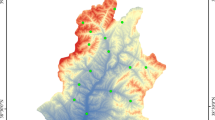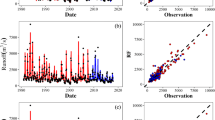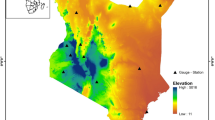Abstract
This study proposes a novel fusion framework for flood forecasting based on machine-learning, statistical, and geostatistical models for daily multiple-step-ahead and near-future under climate change scenarios. An efficient machine-learning model with three remote-sensing precipitation products, including ERA5, CHIRPS, and PERSIANN-CDR, was applied to gap-fill data. Four individual machine-learning models, including Random Forest, Multiple-Layer Perceptron, Support Vector Machine, and Extreme Learning Machine, were developed twelve days ahead of streamflow modeling. Then, three fusion models, including Random Forest, Bayesian Model Averaging, and Bayesian Maximum Entropy, were applied to combine the outputs of individual machine-learning models. The proposed framework was also implemented to downscale the precipitation variables of three general climate models (GCMs) under SSP5-8.5 and SSP1-2.6 scenarios. The application of this approach is investigated on the Kan River, Iran. The results indicated that individual models illustrated weak performance, especially in far-step-ahead flood forecasting, so it is necessary to utilize a fusion technique to improve the results. The RF model indicated high efficiency in the fusion step compared to other fusion-based models. This technique also demonstrated effective proficiency in downscaling daily precipitation data of GCMs. Finally, the flood forecasting model was developed based on the fusion framework in the near future (2020–2040) by using precipitation data from two scenarios. We conclude that flood events based on SSP5-8.5 and SSP1-2.6 will increase in the future in our case study. Also, the frequency evaluation shows that floods under SSP1-2.6 will occur about 10% more than SSP5-8.5 in the Kan River basin from 2020 to 2040.








Similar content being viewed by others
References
Ajami NK, Duan Q, Gao X, Sorooshian S (2006) Multiplemodel combination techniques for analysis of hydrological simulations: application to distributed model intercomparison project results. J Hydrometeorol 7:755–768. https://doi.org/10.1175/JHM519.1
Alizadeh MR, Nikoo MR (2018) A fusion-based methodology for meteorological drought estimation using remote sensing data. Remote Sens Environ 211:229–247. https://doi.org/10.1016/j.rse.2018.04.001
Ashouri H, Hsu KL, Sorooshian S, Braithwaite DK, Knapp KR, Cecil LD, Nelson BR, Prat OP (2015) Bull Am Meteorol Soc 96:69–83. https://doi.org/10.1175/BAMS-D-13-00068.1. PERSIANN-CDR: Daily precipitation climate data record from multisatellite observations for hydrological and climate studies
Badrzadeh H, Sarukkalige R, Jayawardena AW (2015) Hourly runoff forecasting for flood risk management: application of various computational intelligence models. J Hydrol 529:1633–1643. https://doi.org/10.1016/j.jhydrol.2015.07.057
Bae DH, Jeong DM, Kim G (2007) Monthly dam inflow forecasts using weather forecasting information and neuro-fuzzy technique. Hydrol Sci J 52:99–113. https://doi.org/10.1623/hysj.52.1.99
Barezaei A, Jalali J (2023) A comparison of simulated runoff based on ground rain gauges and Persian-CDR satellite precipitation records using SWAT model. ISPRS Ann Photogramm Remote Sens Spat Inf Sci X–4/W1–2022:87–94. https://doi.org/10.5194/isprs-annals-X-4-W1-2022-87-2023
Bellos V, Tsakiris G (2016) A hybrid method for flood simulation in small catchments combining hydrodynamic and hydrological techniques. J Hydrol 540:331–339. https://doi.org/10.1016/j.jhydrol.2016.06.040
Beven K, Freer J (2001) Equifinality, data assimilation, and uncertainty estimation in mechanistic modeling of complex environmental systems using the GLUE methodology. J Hydrol 249:11–29. https://doi.org/10.1016/S0022-1694(01)00421-8
Breiman L (2001) Random forests. Mach Learn 45:5–32. https://doi.org/10.1023/A:1010933404324
Breiman L, Friedman J, Olshen R, Stone C (1984) Classification and Regression Trees–Crc Press (Boca Raton, Florida).https://doi.org/10.1201/9781315139470
Burgan HI (2022) Comparison of different ANN (FFBP, GRNN, RBF) algorithms and multiple Linear regression for daily streamflow prediction in Kocasu River, Turkey. Fresenius Environ Bull 31:4699–4708
Castangia M, Grajales LM, Aliberti A, Rossi C, Macii A, Macii E, Patti E (2023) Transformer neural networks for interpretable flood forecasting. Environ Model Softw 160:105581. https://doi.org/10.1016/j.envsoft.2022.105581
Chang FJ, Chen PA, Lu YR, Huang E, Chang KY (2014) Real-time mult-step-ahead water level forecasting by recurrent neural networks for urban flood control. J Hydrol 517:836–846. https://doi.org/10.1016/j.jhydrol.2014.06.013
Chen L, Sun N, Zhou C, Zhou J, Zhou Y, Zhang J, Zhou Q (2018) Flood forecasting based on an improved extreme learning machine model combined with the backtracking search optimization algorithm. Water 10:1362. https://doi.org/10.3390/w10101362
Chowdhury ME, Islam AS, Lemans M, Hegnauer M, Sajib AR, Pieu NM, Das MK, Shadia N, Haque A, Roy B, Billah M (2023) An efficient flash flood forecasting system for the un-gaged Meghna basin using open source platform Delft-FEWS. Environ Model Softw 161:105614. https://doi.org/10.1061/(ASCE)HE.1943-5584.0000932
Christakos G (1998) Spatiotemporal information systems in soil and environmental sciences. Geoderma 85:141–179. https://doi.org/10.1016/S0016-7061(98)00018-4
Christakos G, Serre ML (2000) BME analysis of spatiotemporal particulate matter distributions in North Carolina. Atmos Environ 34:3393–3406. https://doi.org/10.1016/S1352-2310(00)00080-7
Copernicus Climate Change Service C3S (2017) ERA5: Fifth generation of ECMWF atmospheric reanalyses of the global climate. Copernicus climate change Service climate data store (CDS)
Dasarathy BV (1997) Sensor fusion potential exploitation-innovative architectures and illustrative applications. Proc IEEE 85:24–38. https://doi.org/10.1109/5.554206
Dtissibe FY, Ari AAA, Titouna C, Thiare O, Gueroui AM (2020) Flood forecasting based on an artificial neural network scheme. Nat Hazards 104:1211–1237. https://doi.org/10.1007/s11069-020-04211-5
Durga Rao KH, Dadhwal VK, Sharma JR (2011) A distributed model for real-time flood forecasting in the Godavari basin using space inputs. Int J Disaster Risk Sci 2:31–40. https://doi.org/10.1007/s13753-011-0014-7
Fooladi M, Golmohammadi MH, Safavi HR, Singh VP (2021) Fusion-based framework for meteorological drought modelling using remotely sensed datasets under climate change scenarios: resilience, vulnerability, and frequency analysis. J Environ Manage 297:113283. https://doi.org/10.1016/j.jenvman.2021.113283
Fooladi M, Golmohammadi MH, Rahimi I, Safavi HR, Nikoo MR (2023) Assessing the changeability of precipitation patterns using multiple remote sensing data and an efficient uncertainty method over different climate regions of Iran. Expert Syst Appl 221:119788. https://doi.org/10.1016/j.eswa.2023.119788
Fragoso TM, Bertoli W, Louzada F (2018) Bayesian Model Averaging: a systematic review and conceptual classification. Int Stat Rev 86:1–28. https://doi.org/10.1111/insr.12243
Funk C, Peterson P, Landsfeld M, Pedreros D, Verdin J, Shukla S et al (2015) The climate hazards infrared precipitation with stations—a new environmental record for monitoring extremes. Sci data 2:1–21. https://doi.org/10.1038/sdata.2015.66
Ghazipour F, Mahjouri N (2022) A multiple-model data fusion methodology for seasonal drought forecasting under uncertainty: application of bayesian maximum entropy. J Environ Manage. https://doi.org/10.1016/j.jenvman.2021.114245
Goldenson N, Leung LR, Mearns LO, Pierce DW, Reed KA, Simpson IR, Rahimi S (2023) Use-Inspired, process-oriented GCM selection: prioritizing models for Regional Dynamical Downscaling. Bull Am Meteorol Soc 104(9):E1619–E1629. https://doi.org/10.1175/BAMS-D-23-0100.1
Hobeichi S, Nishant N, Shao Y, Abramowitz G, Pitman A, Sherwood S, Green S (2023) Using machine learning to cut the cost of dynamical downscaling. Earths Future 11(3). https://doi.org/10.1016/j.jhydrol.2022.128592
ICHARM Report (2009) Global trends in water related disasters: an insight for policymakers. International Centre for Water Hazard and Risk Management (UNESCO), Tsukuba, Japan
IPCC: Climate Change (2013) The physical science basis. Contribution of Working Group I to the Fifth Assessment Report of the Intergovernmental Panel on Climate Change. Cambridge University Press, Cambridge, United Kingdom and New York, NY, USA
IPCC: Climate Change (2021) The physical science basis. Contribution of Working Group I to the Sixth Assessment Report of the Intergovernmental Panel on Climate Change. Cambridge University Press, Cambridge, United Kingdom and New York, NY, USA, p 2391. https://doi.org/10.1017/9781009157896
Jahangir MH, Reineh SMM, Abolghasemi M (2019) Spatial predication of flood zonation mapping in Kan River Basin, Iran, using artificial neural network algorithm. Weather Clim Extremes 25:100215. https://doi.org/10.1016/j.wace.2019.100215
Jodhani KH, Patel D, Madhavan N (2021) A review on analysis of flood modelling using different numerical models. Materials Today: Proceedings
Kamali S, Asghari K (2023) The effect of meteorological and hydrological drought on groundwater storage under climate change scenarios. Water Resour Manage 37(8):2925–2943
Khairudin NM, Mustapha NA, Aris TNM, Zolkepli M (2022) In-Depth review on machine learning models for long-term flood forecasting. J Theor Appl Inf Technol 100:1–19
Latt ZZ, Wittenberg H (2014) Improving flood forecasting in a developing country: a comparative study of stepwise multiple linear regression and artificial neural network. Water Resour Manage 28:2109–2128. https://doi.org/10.1007/s11269-014-0600-8
Lee J, Hwang S (2023) Ungauged Basin Flood Prediction using long short-term memory and Unstructured Social Media Data. Water 15(21):3818. https://doi.org/10.3390/w15213818
Lima FN, Freitas ACV, Silva J (2023) Climate Change Flood Risk Analysis: application of Dynamical Downscaling and Hydrological modeling. Atmosphere 14(7):1069. https://doi.org/10.3390/atmos14071069
Lohani AK, Goel NK, Bhatia KKS (2014) Improving real time flood forecasting using fuzzy inference system. J Hydrol 509:25–41. https://doi.org/10.1016/j.jhydrol.2013.11.021
Malekpour Heydari S, Aris TNM, Yaakob R, Hamdan H (2021) Data-Driven forecasting and modelling of Runoff Flow to Reduce Flood Risk using a novel hybrid wavelet-neural network based on feature extraction. Sustainability 13:11537. https://doi.org/10.3390/su132011537
Marker MS, Clark SQ, Gooda M, Min Y, Chen Y (2005) Improved flood forecasting for the Yangtze River in China. In 8th international river symposium, Brisbane, 5th–9th September
Modaresi F, Araghinejad S, Ebrahimi K (2018) Selected model fusion: an approach for improving the accuracy of monthly streamflow forecasting. J Hydroinform 20:917–933. https://doi.org/10.2166/hydro.2018.098
Mosavi A, Ozturk P, Chau KW (2018) Flood prediction using machine learning models: literature review. Water 10:1536. https://doi.org/10.3390/w10111536
Motevalli S, Hosseinzadeh M, Esmaili R, Derafshi K, Gharehchahi S (2012) Assessing the effects of land use change on hydrologic balance of Kan watershed using SCS and HEC-HMS hydrological models—Tehran. Iran Aust J Basic Appl Sci 6:510–519
Muñoz P, Orellana-Alvear J, Willems P, Célleri R (2018) Flash-flood forecasting in an Andean mountain catchment—development of a step-wise methodology based on the random forest algorithm. Water 10:1519. https://doi.org/10.3390/w10111519
Najafi MR, Moradkhani H, Wherry SA (2011) Statistical downscaling of precipitation using machine learning with optimal predictor selection. J Hydrol Eng 16:650–664. https://doi.org/10.1061/(ASCE)HE.1943-5584.0000355
Nguyen PKT, Chua LHC, Son LH (2014) Flood forecasting in large rivers with data-driven models. Nat Hazards 71:767–784. https://doi.org/10.1007/s11069-013-0920-7
Nishant N, Hobeichi S, Sherwood S, Abramowitz G, Shao Y, Bishop C, Pitman A (2023) Comparison of a novel machine learning approach with dynamical downscaling for Australian precipitation. Environ Res Lett 18(9):094006. https://doi.org/10.1088/1748-9326/ace463
Noymanee J, Nikitin NO, Kalyuzhnaya AV (2017) Urban pluvial flood forecasting using open data with machine learning techniques in pattani basin. Procedia Comput Sci 119:288–297. https://doi.org/10.1016/j.procs.2017.11.187
Peng T, Zhou J, Zhang C, Fu W (2017) Streamflow forecasting using empirical wavelet transform and artificial neural networks. Water 9:406. https://doi.org/10.3390/w9060406
Raftery AE, Gneiting T, Balabdaoui F, Polakowski M (2005) Using bayesian model averaging to calibrate forecast ensembles. Mon Weather Rev 133:1155–1174. https://doi.org/10.1175/MWR2906.1
Rodriguez-Galiano V, Mendes MP, Garcia-Soldado MJ, Chica-Olmo M, Ribeiro L (2014) Predictive modelling of groundwater nitrate pollution using Random Forest and multisource variables related to intrinsic and specific vulnerability: a case study in an agricultural setting (Southern Spain). Sci Total Environ 476:189–206. https://doi.org/10.1016/j.scitotenv.2014.01.001
Roshani R (2003) Evaluating the effect of check dams on flood peaks to optimize the flood control measures (Kan case study in Iran). Interntional institute for geo information science and earth observation enschede, the Netherland
Saedi F, Ahmadi A, Abbaspour KC (2021) Optimal water allocation of the Zayandeh-Roud Reservoir in Iran based on inflow projection under climate change scenarios. J Water Clim Change 12:2068–2081. https://doi.org/10.2166/wcc.2021.219
Schneider C, Laiz´e CLR, Acreman MC, Florke M (2013) How will climate change modify river flow regimes in Europe? Hydrol. Earth Syst Sci 17(1):325–339
Stouffer RJ, Eyring V, Meehl GA, Bony S, Senior C, Stevens B, Taylor KE (2017) CMIP5 scientific gaps and recommendations for CMIP6. Bull Am Meteorol Soc 98:95–105. https://doi.org/10.1175/BAMS-D-15-00013.1
Sun N, Zhang S, Peng T, Zhang N, Zhou J, Zhang H (2022) Multi-variables-driven Model based on Random Forest and gaussian process regression for monthly streamflow forecasting. Water 14:828. https://doi.org/10.3390/w14111828
Tabbussum R, Dar AQ (2021) Modelling hybrid and backpropagation adaptive neuro-fuzzy inference systems for flood forecasting. Nat Hazards 108:519–566. https://doi.org/10.1007/s11069-021-04694-w
Tan QF, Lei XH, Wang X, Wang H, Wen X, Ji Y, Kang AQ (2018) An adaptive middle and long-term runoff forecast model using EEMD-ANN hybrid approach. J Hydrol 567:767–780. https://doi.org/10.1016/j.jhydrol.2018.01.015
Tayyab M, Xiaohua D, Sibtain M, Ahmad I, Zahra A, Azam MI (2022) Monthly streamflow forecasting using decomposition-based hybridization with two-step Verification Method over the Mangla Watershed, Pakistan. Iran J Sci Technol Trans Civil Eng 1–20. https://doi.org/10.1007/s40996-022-00947-1
Tsakiri K, Marsellos A, Kapetanakis S (2018) Artificial neural network and multipleple linear regression for flood prediction in Mohawk River, New York. Water 10:1158. https://doi.org/10.3390/w10091158
Tufa FG, Sime CH (2021) Stream flow modelling using SWAT model and the model performance evaluation in Toba sub-watershed. Ethiopia Modelling Earth Syst Environ 7:2653–2665. https://doi.org/10.1007/s40808-020-01039-7
Usul N, Turan B (2006) Flood forecasting and analysis within the Ulus Basin, Turkey, using geographic information systems. Nat Hazards 39:213–229. https://doi.org/10.1007/s11069-006-0024-8
Vapnik VN (1995) The Nature of Statistical Learning Theory, The Nature of Statistical Learning Theory. https://doi.org/10.1007/978-1-4757-2440-0
Vosoughi F, Nikoo MR, Rakhshandehroo G, Alamdari N, Gandomi AH, Al-Wardy M (2022) The application of bayesian model averaging based on artificial intelligent models in estimating multiplephase shock flood waves. Neural Comput Appl 1–19. https://doi.org/10.1007/s00521-022-07528-3
Vrugt JA (2017) MODELAVG: A MATLAB toolbox for post-processing of model ensembles
Vrugt JA, Ter Braak CJ, Clark MP, Hyman JM, Robinson BA (2008) Treatment of input uncertainty in hydrologic modelling: doing hydrology backward with Markov chain Monte Carlo simulation. Water Resour Res. https://doi.org/10.1029/2007WR006720
Vrugt JA, Ter Braak CJF, Diks CGH, Robinson BA, Hyman JM, Higdon D (2009) Accelerating Markov chain Monte Carlo simulation by differential evolution with self-adaptive randomized subspace sampling. Int J Nonlinear Sci Numer Simul 10:273–290. https://doi.org/10.1515/IJNSNS.2009.10.3.273
World Meteorological Organization (2006) TECHNICAL REGULATIONS
Xing B, Gan R, Liu G, Liu Z, Zhang J, Ren Y (2016) Monthly mean streamflow prediction based on bat algorithm-support vector machine. J Hydrol Eng 21:04015057. https://doi.org/10.1061/(ASCE)HE.1943-5584.0001269
Zhou J, Peng T, Zhang C, Sun N (2018) Data pre-analysis and ensemble of various artificial neural networks for monthly streamflow forecasting. Water 10:628. https://doi.org/10.3390/w10050628
Acknowledgements
The authors would like to thank Prof. Jasper Vrugt, who provided the MODELAVG toolbox for Dr. Mohammad Reza Nikoo and STEMLAB for the STAR-BME code.
Funding
This research received no specific grants from funding agencies in the public, commercial, or not-for-profit sectors.
Author information
Authors and Affiliations
Corresponding author
Ethics declarations
Ethical approval
Not applicable, because this article does not contain any studies with human or animal subjects.
Consent to participate
The data of this research were not prepared through a questionnaire.
Consent for publication
There is no conflict of interest regarding the publication of this article. The authors of the paper make sure that everyone agrees to submit the paper and is aware of the submission.
Conflict of interest
The authors declare that they have no known competing financial interests or personal relationships that could have appeared to influence the work reported in this paper.
Additional information
Publisher’s Note
Springer Nature remains neutral with regard to jurisdictional claims in published maps and institutional affiliations.
Rights and permissions
Springer Nature or its licensor (e.g. a society or other partner) holds exclusive rights to this article under a publishing agreement with the author(s) or other rightsholder(s); author self-archiving of the accepted manuscript version of this article is solely governed by the terms of such publishing agreement and applicable law.
About this article
Cite this article
Khajehali, M., Safavi, H.R., Nikoo, M.R. et al. A fusion-based framework for daily flood forecasting in multiple-step-ahead and near-future under climate change scenarios: a case study of the Kan River, Iran. Nat Hazards (2024). https://doi.org/10.1007/s11069-024-06528-x
Received:
Accepted:
Published:
DOI: https://doi.org/10.1007/s11069-024-06528-x




